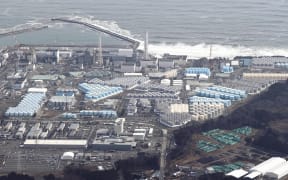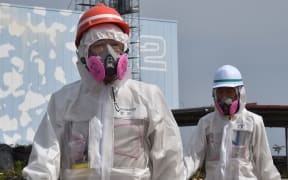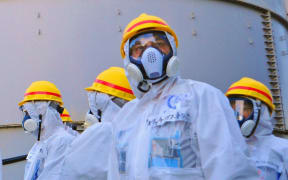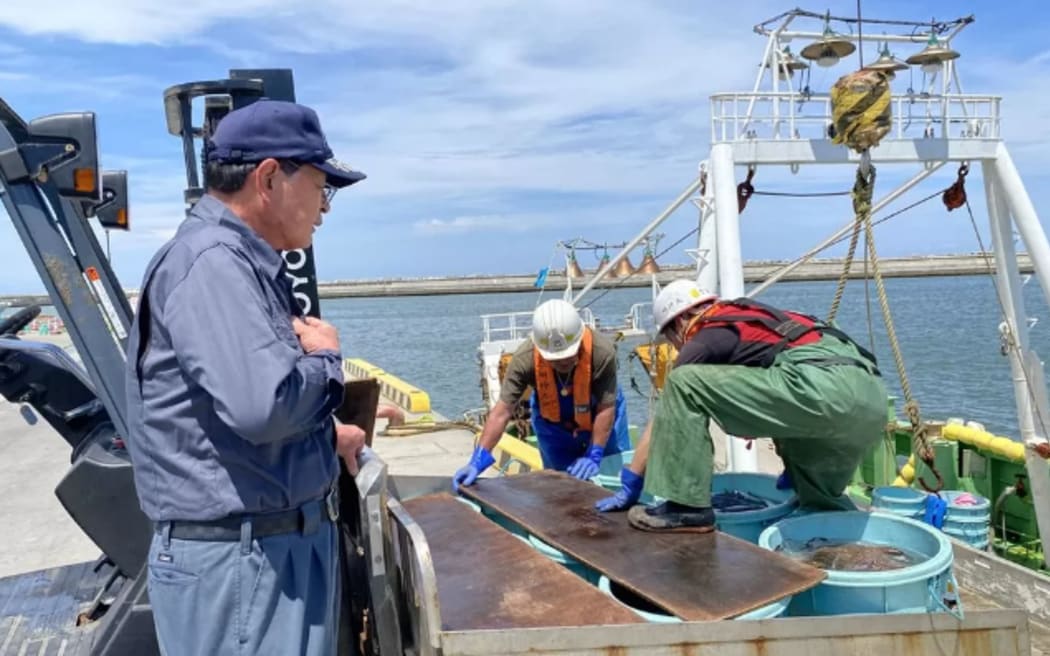
Toru Takahashi (left), whose family own a fishing business, says the fear about a controversial release of treated water from Fukushima Daiichi nuclear power plant has already hurt his business Photo: BBC/ Jiro Akiba
By Shaimaa Khalil, BBC Tokyo correspondent
Locals struggle to believe the Fukushima Daiichi nuclear power plant's treated radioactive water is safe to pump into the Pacific Ocean.
In a white coat and gloves, Ai Kimura is cutting up a fish sample at the Tarachine lab, about an hour's drive from the now-crippled Fukushima Daiichi nuclear power plant on Japan's eastern coast.
Four times a year, Kimura and her team of volunteers collect samples of fish from the waters around the plant. They have been doing this since the lab was founded in 2011, just months after a devastating tsunami flooded the reactors, causing a radiation leak.
Except Kimura is not a scientist - and neither are any of the women who run the non-profit lab, whose name Tarachine is derived from the term for "mother" in old Japanese. Shaken after the tsunami, Kimura says locals started the lab to find out what was safe to feed their children because it was hard to come by information on the risks of radiation.
They asked technical experts to train them on how to test for radioactive substances and log the readings, raised funds and began educating themselves.
It was the decision of a shattered community that never thought an accident at the nuclear power plant was possible. Now, 12 years on, they again find themselves struggling to trust the Japanese government as it insists it's safe to release treated radioactive water from the plant into the Pacific Ocean.
Earlier this month, Japan received the green light to start pumping more than a million tonnes - about the same volume as 500 Olympic-size pools - of the treated water that has been used to cool the melted reactors. It has accumulated in more than a 1000 tanks and now, as they reach capacity, it needs to go somewhere.
Japan's nuclear regulator has given Tokyo Electric Power Company Holdings (Tepco), which runs the plant, the go-ahead.
The International Atomic Energy Agency (IAEA) chief Rafael Grossi said the watchdog's two-year review found that the plan complies with international standards and the treated water will have "a negligible radiological impact on people and the environment". Neighbouring South Korea too delivered a similar assessment, despite sticking to a ban on some Japanese food imports. China and Hong Kong have announced similar bans.
But the people who live in and around Fukushima are not convinced.
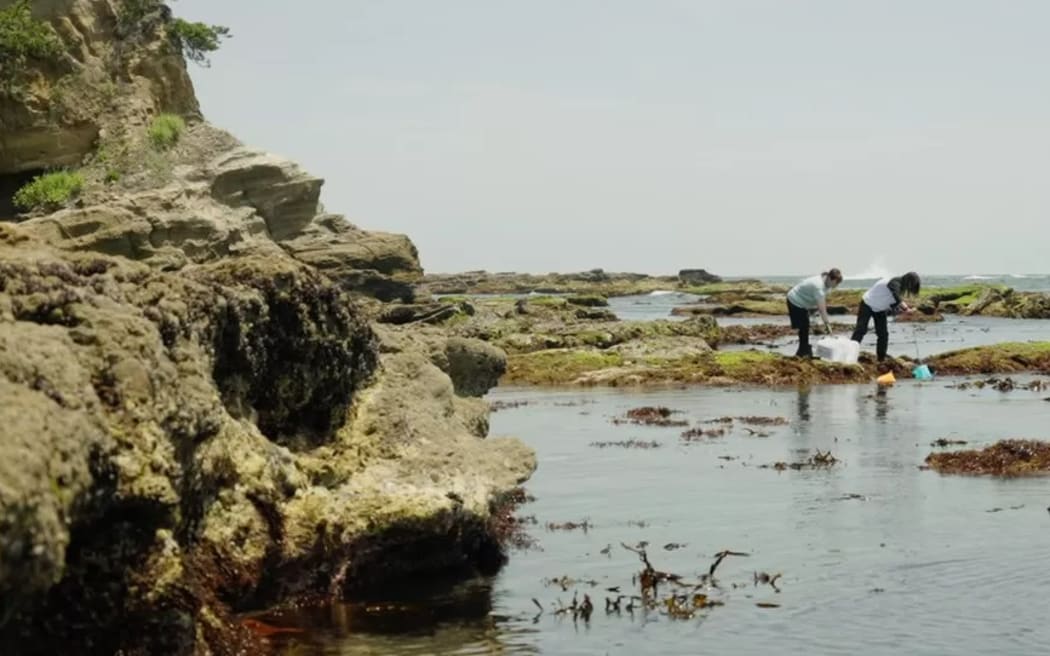
Volunteers from Tarachine collect samples from the sea around the Fukushima plant Photo: BBC/ Jiro Akiba
"We still don't know the extent to which the contaminated water has been treated. That's why we oppose the release," Kimura says, adding that many local families are worried about the discharge of the treated water.
Tepco has been filtering the water to remove more than 60 radioactive substances, but the water will not be entirely radiation-free. It will have tritium and carbon-14, radioactive isotopes of hydrogen and carbon respectively that cannot be easily removed from water. But experts say they are not a danger unless consumed in large quantities because they emit very low levels of radiation. That's also why before the filtered water is released it will go through another phase of treatment where it's diluted with seawater to reduce the remaining substances' concentrations.
Japan's government has said that by the end of the filtration and testing process, the treated water will be no different than the water released by nuclear plants around the world.
'The invisible enemy'
But the facts are up against fear in Fukushima, where the reminders of the "invisible enemy" - as many here call radiation - are constant.
After the disaster the government declared a 30km exclusion area around the plant, evacuating more than 150,000 people. Although a lot has changed, whole neighbourhoods are still empty and greenery covers the roofs and windows of long-abandoned homes. Signs on storefronts have faded away but metal barriers and yellow tape warning people to keep out remain on the narrow, deserted streets.
Even the Tarachine lab is proof of how much the community fears the "invisible enemy", despite assurances to the contrary.
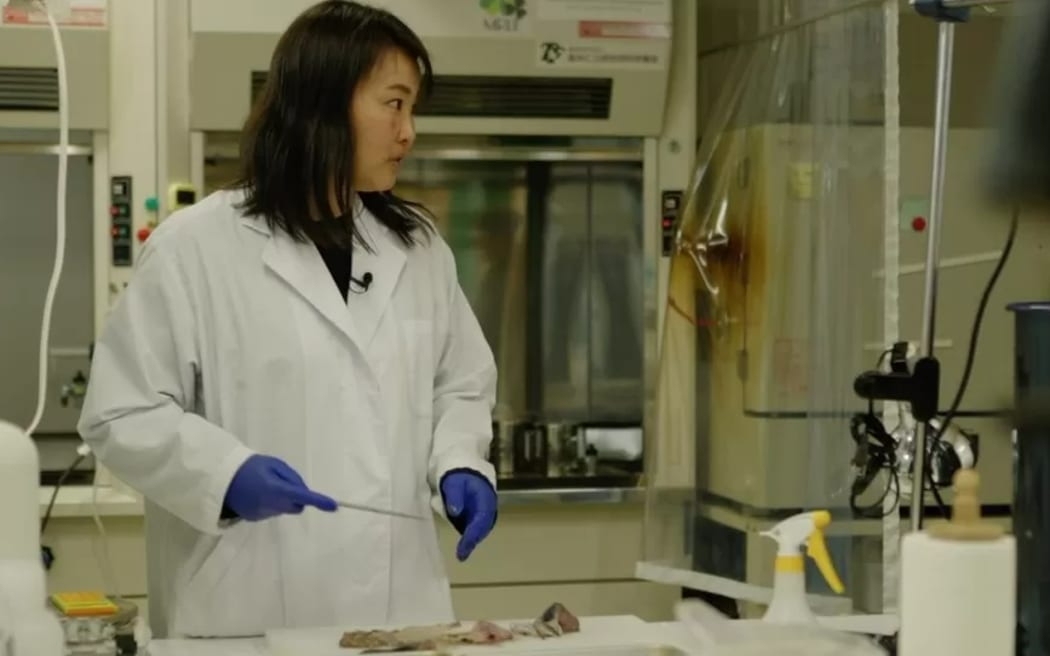
Ai Kimura tests samples for radiation at the Tarachine lab Photo: BBC/ Jiro Akiba
In the main lab, one volunteer is chopping cabbage before taking it to be measured for gamma radiation, and another is treating water before the sample is tested. In the hallway there are bags of soil and dust from vacuum cleaners that have been used in homes nearby. At the back of the room, food samples are dried before they're tested for radiation. On the walls, there are charts and maps of the nuclear plant and the sea around it, with markings in various colours to show the degree of radiation and how far it has travelled.
The women collect samples but they also test material sent to them by local people.
"Some families brought us acorns [to test]," Kimura said. "In Japan we make spinning tops from acorns with toothpicks. The government wouldn't think to check that. We were asked by some mothers to measure the radiation levels at their local park."
The lab measures all sorts of samples for radioactive substances such as strontium-90, tritium and caesium-134 and 137, tracking their levels over the years.
"We upload all our findings on our website so anybody can find it," Kimura says. "We have been able to confirm that radioactive substances have decreased gradually in the food we measure. If they release the water, it's ultimately undoing the power of nature that brought it to this level."
She sees the contentious plan as a big step backwards. She says there are still "lingering emotional wounds" from the 2011 disaster and this decision is reopening them.
The plan - in the works for two years now - is a necessary step in the lengthy and costly clean-up, experts say. For the plant to be decommissioned, the radioactive debris inside the melted reactors must be removed. And to do that, they must first discharge the water that has been used to cool the reactors since a tsunami crippled the plant in 2011.
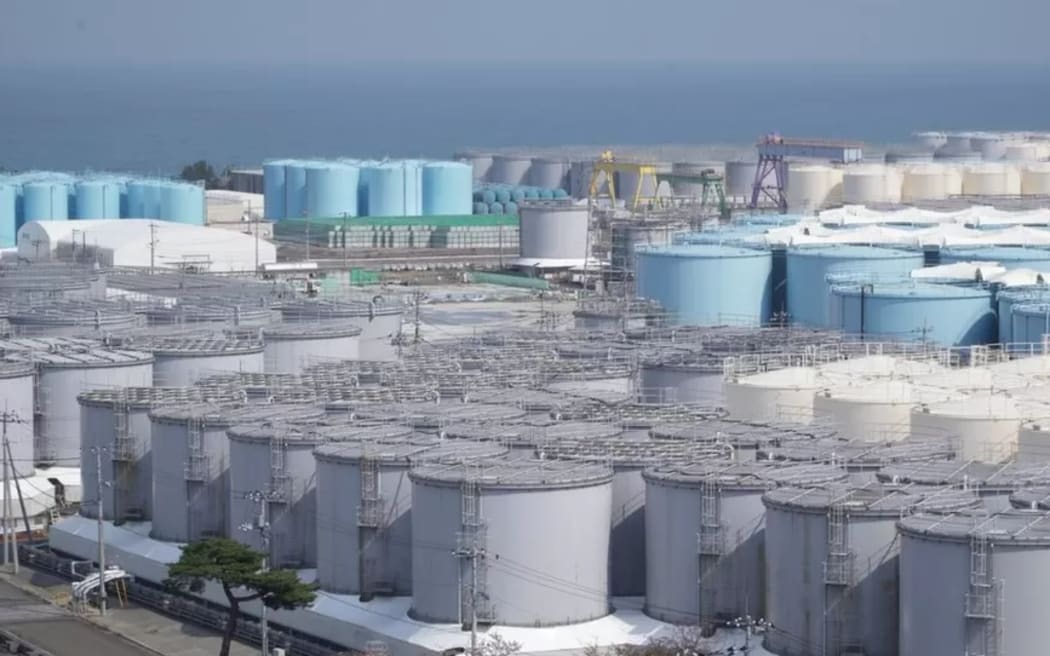
The treated radioactive water is being stored in more than 1000 tanks Photo: BBC/ Jiro Akiba
In March, Tepco's boss Akira Ono told the Associated Press that they're only now beginning to fully comprehend the damage inside the reactors. The most pressing task, he said, was to safely start releasing the water to clear the area around the plant. They also need to make room for more water because the melted debris needs to be cooled throughout.
"The real problem is not the actual physical effect of the radiation. It's our fear of it," says molecular pathology expert Gerry Thomas, who worked with Japanese scientists on radiation research and advised the IAEA as well.
She says the science was lost among warring nuclear activists soon after the disaster, and to reassure a shocked and terrified population, the government went to great lengths to show they were taking all the necessary precautions.
"The politicians are trying to prove they're cautious and, you know, they're looking after everybody. But actually, the message that people receive is, well, this stuff must be really, really dangerous."
The long arm of fear
And now the fear - and the lack of trust - is proving hard to shake off.
Worse, it's also affecting livelihoods. Fishermen say that discharging the treated water will tarnish the reputation of their catch, driving prices and already struggling businesses down. They say the industry here never recovered fully since the disaster and is still dependent on government subsidies.
Inside the nuclear plant, Tepco official Kazuo Yamanaka points to two fish tanks - one where flatfish swim in regular sea water, and another where they are in water with the same radiation levels as that which will be pumped into the ocean. He says the fish are closely monitored - while there is a rise in tritium levels inside them at first, it plateaus and then the fish flush it out of their system once they're back in standard sea water.
"I am a radiation expert, so I know that tritium has very little effect on the human body and living organisms," he said. "We are all concerned about the same thing - radiation - and that is why we are so anxious. I hope that these data and images will help to reassure people a little.
Toru Takahashi, whose family has been fishing for three generations, is far from reassured: "We're against it. We're already seeing the negative effects. We've seen contractors who say they won't buy Fukushima products."
For him, this is personal. Giving up the family business is not an option, he says, as he supervises port staff who unload buckets of fish to wash and make ready for auction and then the market.
He says it's a fraction of the business they had before the 2011 disaster: "We are still at 300 million yen [a year], including all the small boats. Before, we made around 700m yen [$NZ3.4m; $NZ7.9m]."
He fears it might get worse once the water is released, given the import bans already announced by China and South Korea.
When asked if sound science is enough to overcome these concerns, Yamanaka admitted that "we cannot control the reputation, no matter how nicely we dress it up", adding that "we believe our efforts will one day settle these arguments".
"I know we've lost the trust of the people - it'll take time to get it back."
-This story was first published by BBC
